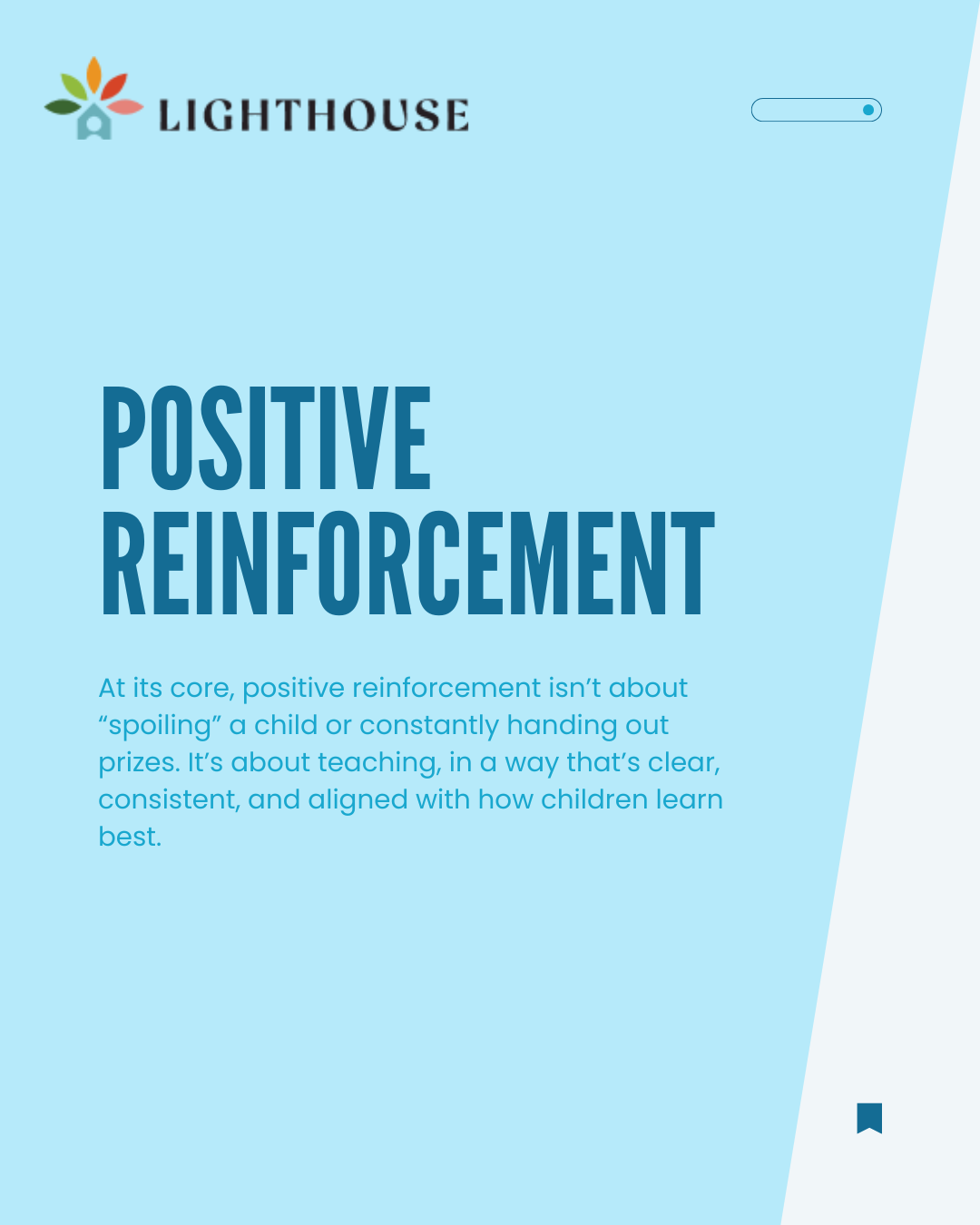Key Points:
- Positive reinforcement is a core strategy in ABA therapy, encouraging behaviors by adding something motivating after the behavior occurs.
- When used correctly, reinforcement can shape communication, social, and daily living skills in children with autism.
- Understanding what works as reinforcement—and what doesn’t—can help parents support their child’s development at home.
When your child does something great—maybe they make eye contact, use a new word, or try a bite of a new food—what happens next can shape whether that behavior happens again. That’s where positive reinforcement comes in. For children with autism, this concept isn’t just helpful—it’s foundational.
In Applied Behavior Analysis (ABA), positive reinforcement for autism means delivering something meaningful and motivating immediately after a behavior to increase the likelihood that the behavior will happen again. It might be praise, a favorite toy, a high-five, or even access to screen time. But there’s more to it than just doling out rewards.
This guide will walk you through what positive reinforcement really is, how to use it effectively, and what to avoid—so you can help support your child’s learning in a consistent, meaningful way.
 What Is Positive Reinforcement, Really?
What Is Positive Reinforcement, Really?
Positive reinforcement is one of those terms that gets thrown around a lot, but in behavior analysis, it has a very specific definition. It means adding something immediately after a behavior that increases the future occurrence of that behavior. The key is that the behavior needs to actually increase over time—if it doesn’t, then the “reinforcement” wasn’t reinforcing.
For children with autism, reinforcement plays a central role in building communication, daily living skills, emotional regulation, and social behavior. While consequences like punishment might temporarily stop a behavior, reinforcement builds behaviors up—and that’s what we’re after when teaching a new skill.
It’s also not one-size-fits-all. What’s reinforcing for one child might not be for another. Some kids love tickles, others prefer silence and space. Your job is to figure out what motivates your child—and then learn how to use it strategically.
Reinforcement vs. Bribery: There’s a Big Difference
This is a concern many parents have—won’t I be bribing my child if I give them something every time they do what I ask?
Not if you’re doing it correctly.
Here’s the key difference: bribery is when a reward is offered to stop a behavior already in progress (e.g., “If you stop screaming, I’ll give you a cookie”). Reinforcement, on the other hand, is planned and delivered after a behavior you want to see more often (e.g., “You asked for help with your words—nice job! Let’s play your favorite game”).
When done right, positive reinforcement teaches new behaviors in a clear and consistent way. It helps your child understand what works in getting their needs met—and that’s a big win.
When and How to Use Positive Reinforcement: A Parent’s Guide
It’s not just about giving your child a reward—it’s about how and when you do it. Timing, consistency, and matching the right reinforcer to the right situation all matter.
Let’s break it down.
- Choose Reinforcers Based on Your Child’s Preferences
This is known as conducting a preference assessment. You may already have a sense of what your child loves—spinning toys, bubbles, snack foods, songs—but it’s worth checking regularly.
Preferences can shift, and novelty matters. Even something highly preferred can lose its impact if it’s always available. Try:
- Offering two or three items and seeing what your child chooses.
- Noticing what they go to on their own.
- Rotating items to keep them exciting.

- Deliver the Reinforcer Immediately
The power of reinforcement lies in the timing. A delay of even a few seconds can reduce its effectiveness, especially for younger children or those with communication challenges.
So, if your child follows a direction, delivers eye contact, or uses a communication tool—reinforce right away.
- Be Specific in Your Praise
General praise is good, but descriptive praise is better. Instead of saying “Good job,” try “Nice job asking for help with your words!” or “I love how you waited your turn!”
This not only reinforces the behavior, but helps your child understand exactly what earned them the reinforcement.
- Match the Reinforcer to the Effort
Small behaviors can earn small reinforcers. Bigger, more complex or difficult tasks might require something more motivating. Think about how hard the task was from your child’s perspective.
For example:
- Putting away a toy might earn a high-five.
- Tolerating a haircut might earn 10 minutes of a favorite video.
- Fade the Reinforcer Over Time
We don’t want kids depending on a reward every time they brush their teeth or say “hi” to a peer. Once a behavior becomes more reliable, you can fade the reinforcement by:
- Delivering it less frequently.
- Replacing external rewards with social praise.
- Making reinforcement part of a natural routine (e.g., “We clean up, then we play!”).
Common Pitfalls to Avoid
Even with the best intentions, there are a few common mistakes parents make when using reinforcement. Knowing these can help you avoid frustration down the road.
Before we dive into the list, know this: it’s okay to stumble. Behavior change—for kids and adults—takes practice.
Here are a few things to watch for:
- Reinforcing the Wrong Behavior
Sometimes we accidentally reinforce what we don’t want to see. If your child cries and then gets what they want, crying just got reinforced. Try to reinforce the more appropriate behavior instead, even if it’s small (like a gesture or sound that approximates a request). - Using the Same Reinforcer Too Often
Even the most exciting item loses its shine if it’s always available. If a favorite toy is used all day long, it won’t be as motivating when it’s time to work. Keep reinforcers novel and rotate them regularly. - Waiting Too Long
If the reinforcement comes too late, your child may not connect it with their behavior. Try to deliver reinforcement within 1-2 seconds when possible, especially early in the learning process. - Reinforcing Too Many Behaviors at Once
Reinforcement is most effective when it targets specific behaviors. If you reinforce everything at once, it becomes harder for your child to connect the dots. Focus on one or two target behaviors at a time. - Failing to Fade
We don’t want kids to become dependent on a treat every time they complete a task. Once the behavior becomes more frequent and consistent, gradually shift to more natural rewards like praise, routines, or social play.
 Examples of Positive Reinforcement in Daily Life
Examples of Positive Reinforcement in Daily Life
The principles of reinforcement aren’t limited to therapy sessions—they belong in everyday routines. Here are a few examples of how parents can embed positive reinforcement throughout the day.
- Morning Routine
- Behavior: Brushing teeth independently
- Reinforcer: Extra 2 minutes of music time while getting dressed
- Why it works: Links a necessary task to a preferred activity
- Mealtime
- Behavior: Trying a new food
- Reinforcer: Sticker for food chart or preferred snack after meal
- Why it works: Offers tangible motivation while building tolerance
- Play Dates
- Behavior: Sharing a toy for the first time
- Reinforcer: Parent joins in play for a few minutes
- Why it works: Social reinforcement can be more powerful than objects
- Communication
- Behavior: Using a picture exchange to ask for a toy
- Reinforcer: Immediate access to the toy
- Why it works: Direct connection between communication and reward
- Transitions
- Behavior: Transitioning from iPad to bath without a meltdown
- Reinforcer: Choice of favorite towel or bath toy
- Why it works: Keeps transitions positive without bribing
 Summary: Why Positive Reinforcement Matters
Summary: Why Positive Reinforcement Matters
For children with autism, reinforcement builds the bridge between effort and outcome—between communication and connection.
Used thoughtfully, it can support everything from language development and daily routines to emotional regulation and social success. And it doesn’t require fancy tools or expensive materials—just attention, timing, and an understanding of what truly motivates your child.
Support for Parents: ABA Therapy with Lighthouse
If you’re feeling overwhelmed or unsure about how to implement positive reinforcement consistently—or you just want more guidance—you don’t have to do it alone.
Lighthouse ABA offers personalized, evidence-based ABA therapy services in New York and North Carolina that put reinforcement strategies into action, helping your child build skills in a structured but nurturing environment. Our team is here to support your family every step of the way.
Our therapists use data-driven approaches tailored to your child’s needs, and we work closely with families to make sure skills practiced in sessions transfer into real life. Whether your child is just starting their ABA journey or you’re looking for a more refined approach to support their growth, we’re here to help.
Interested in learning more? Reach out today and find out how we can partner with you to create lasting, meaningful change—one reinforcer at a time.


